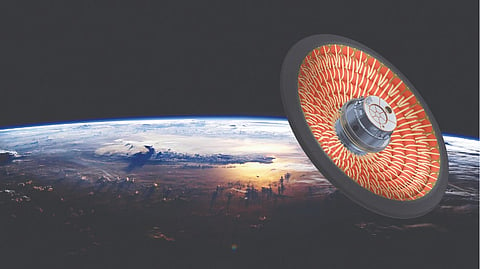

By KENNETH CHANG
Last Thursday, NASA sent a giant inflatable device to space and then brought it back down from orbit, splashing in the ocean near Hawaii. You might think of it as a bouncy castle from space, although the people in charge of the mission would prefer you did not.
“I would say that would be inaccurate,” Neil Cheatwood, principal investigator for the Low-Earth Orbit Flight Test of an Inflatable Decelerator, or LOFTID, said of the comparison during an interview.
LOFTID may sound like just an amusing trick, but the $93 million project demonstrates an intriguing technology that could help NASA in its goal of getting people safely to the surface of Mars someday. The agency has landed a series of robotic spacecraft on Mars, but the current approaches only work for payloads weighing up to about 1.5 tons — about the bulk of a small car.
That is inadequate for the larger landers, carrying 20 tons or more, that are needed for people and the supplies they will need to survive on the red planet.
A more accurate description of the device might be that it is a saucer, 20 feet wide when inflated. It is made of layers of fabric that can survive falling into the atmosphere at 18,000 mph and temperatures close to 3,000 degrees Fahrenheit.
Still, an inflatable heat shield shares a key characteristic with a bouncy castle: Uninflated, it can be folded and packed tightly. LOFTID fit in a cylinder a bit over 4 feet wide and 1 1/2 feet high. For a traditional rigid heat shield, there is no way to cram something 20 feet in diameter into a rocket that is not that wide. A larger surface such as LOFTID’s generates much more air friction — essentially it is a better brake as it slices through the upper atmosphere, and the greater drag allows heavier payloads to be slowed down. For future Mars missions, the inflatable heat shield would be combined with other systems such as parachutes and retrorockets to guide the lander en route to a soft landing.
That would require a heat shield about 30 feet in diameter, Cheatwood said, “because it’s such a high mass we’re trying to take to Mars for humans.”
On Thursday, the LOFTID team did not have much to do during the countdown to liftoff at 1:49 a.m. Pacific time aboard an Atlas V rocket. To avoid the possibility of causing problems with the main mission — the deployment of a weather satellite — the LOFTID systems were not turned on until an hour later, after the satellite was released.
The satellite, Joint Polar Satellite System-2 and now renamed NOAA-21 upon reaching orbit, will measure energy emanating from the planet through the atmosphere to improve weather forecasts.
After the weather satellite was deployed in orbit, the second stage of the rocket, with LOFTID still attached, briefly fired its engine twice to get LOFTID oriented properly for reentry into the atmosphere.
Over the next few minutes, compressed nitrogen gas inflated LOFTID’s heat shield, a set of nested doughnut-shape tubes that looked like a mushroom or a parasol popping out of the top of the rocket stage. To add stability to LOFTID, the rocket stage began spinning like a top at a languid three revolutions per minute before releasing the test craft for its journey through the atmosphere.
Chang is a journalist with NYT©2022
The New York Times
Visit news.dtnext.in to explore our interactive epaper!
Download the DT Next app for more exciting features!
Click here for iOS
Click here for Android